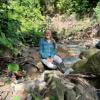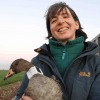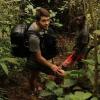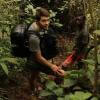Human-wildlife conflict and coexistence is a shockingly common problem, often with enormous consequences for both individual animals and entire populations.
When human-wildlife conflict comes to mind, you may immediately think of wildlife crime instead - which isn't wrong, since many regions with wildlife crime problems like poaching are also areas where people may frequently deal with human-wildlife conflict, causing the two issues to go hand-in-hand. But human-wildlife conflict is a much broader issue encompassing many ways that human presence and interference can cause problems for us and animals alike. Human-wildlife conflict includes:
- Elephants trampling a farmer's crops, resulting in retaliation
- New real estate developments infringing on ecosystems where predator species live, leading to predators having less territory and less food, which in turn leads to predators attacking domestic animals and livestock
- Freeways dividing the territory of animals like mountain lions, leading to wildlife venturing into neighborhoods or being killed by cars
- Lead bullets used in hunting causing scavengers like condors to die of lead poisoning
These are just a few examples of how humans can negatively impact wildlife, and it's clear to see how many of these scenarios could escalate. Human-wildlife conflict solutions don't just include ways in which we can prevent these issues (for example, through tracking predators, monitoring populations' territories, or building barriers and wildlife crossings monitored by sensors), but also the ways in which we can help people connect with wildlife and care about learning to live alongside them.
If you're interested in solutions that can prevent human-wildlife conflict, join this group and get to know the people who are working to protect and save species around the world!
Header image: Casey Allen on Unsplash
No showcases have been added to this group yet.
- @msgunther1
- | she, her
Micaela Szykman Gunther is a Professor in the Department of Wildlife at Cal Poly Humboldt. She applies studies on animal behavior of (mostly) carnivores and (some) ungulates to inform management of wildlife species.
- 0 Resources
- 0 Discussions
- 4 Groups
- @Mohamud
- | He/Him
A passionate Conservationist. Director and Founder to Isiolo County Conservancies Association
- 0 Resources
- 0 Discussions
- 2 Groups
- @Gody
- | He
Godfrey Nyangaresi, a dedicated Protection Manager with 12+ years of wildlife conservation experience. Skilled in technologies, administration, and law enforcement, he leads protection efforts at STEP, ensuring the sustainable conservation of elephants in southern Tanzania.
- 0 Resources
- 3 Discussions
- 17 Groups
- @GalZanir
- | he, him
Luc Hoffman Institute
Wildlife Entrepreneur | Innovation for Nature Conservation | Systems-thinking | Web3.0 | Artificial Intelligence | Agency for nature | DAOs | Rewilding & more
- 1 Resources
- 0 Discussions
- 8 Groups
Wildlife Ecologist
- 0 Resources
- 0 Discussions
- 9 Groups
- @Jackeline
- | She
- 0 Resources
- 0 Discussions
- 7 Groups
- @RHugtenburg
- | He/They
Student at Aberystwyth University. Bug Fanatic🪲. Worked at Octophin Digital for my industrial year placement 🐙.
- 0 Resources
- 0 Discussions
- 19 Groups
Working for India's Forestry and Biodiversity Sector as a country officer of Japan International Cooperation Agency (JICA)
- 2 Resources
- 0 Discussions
- 1 Groups
- @mbkowalski11
- | he/him
University of California Santa Cruz
PhD Student (UCSC, Wilmers Lab) interested in large carnivores, behavioral ecology, human-wildlife coexistence, and biologging
- 0 Resources
- 3 Discussions
- 11 Groups
- @kadambarid
- | she, her, hers
Dr. Kadambari Devarajan is an engineer-turned-ecologist working on biodiversity monitoring. (Website - http://kadambarid.in/)
- 0 Resources
- 0 Discussions
- 14 Groups
Early career, assistance in biologging projects with owls and eagles
- 0 Resources
- 0 Discussions
- 5 Groups
- 2 Resources
- 0 Discussions
- 8 Groups
A recent online video of a baby bear's efforts to scale a steep cliff took what seemed like an inspirational moment viral. But after the initial enthusiasm for the video came some controversy when scientists pointed out...
22 November 2018
In this case study, Katarzyna Nowak writes about her work with the Southern Tanzania Elephant Project (STEP) trialing beehive fences as human-elephant conflict mitigation tools. Earlier this year the research team...
27 August 2018
The understanding of the interplay of movement, behaviour and physiology that biologging offers has applied relevance for a range of fields, including evolutionary ecology, wildlife conservation and behavioural ecology...
30 July 2018
The winners of our Human Wildlife Conflict Tech Challenge are offering regular updates throughout the year to chronicle their failures, successes and what they learn along the way as they develop their solutions. In...
27 July 2018
As people continue to move into natural habitats, conflicts between human beings and wildlife continue to rise. Although there are a number of early-detection systems and tools in place to prevent human-wildlife...
5 June 2018
Conflict between humans and wildlife is increasing as human communities expand and wild habitats are destroyed, prompting need for new mitigation techniques. As a winner of the Human Wildlife Conflict Tech Challenge,...
19 April 2018
‘The Field’… Say the words ‘The Field’ to a group of conservationists and it will immediately conjure up vivid memories of everything from sticky wet rainforests to burning dusty deserts. What’s more, it’s almost...
17 January 2018
Article
A new research project is looking to investigate whether technology combined with the ancient skills and knowledge of Namibian trackers can help save cheetahs from extinction. Called FIT Cheetahs, the research project...
4 December 2017
We are delighted to announce that British conservation technologist Alasdair Davies and the Dutch team of Laurens de Groot and Tim van Dam from the ShadowView Foundation are the winners of the first international Human...
1 November 2017
Our panel of international experts has been hard at work reviewing the 47 proposals we recieved for innovative technological tools to address human wildlife conflict. The panelists have systematically been assessing the...
20 October 2017
The inherent complexity of not only deploying technologies in the field but also doing so in a scientifically rigorous manner can prove a substantial barrier for the effective use of conservation technologies, and clear...
11 October 2017
The Domain Awareness System (DAS) is a revolution in monitoring technology, creating real-time awareness of protected areas assets. This technology has the potential to completely change standard monitoring procedures...
26 September 2017
October 2025
event
November 2023
September 2023
event
July 2023
event
32 Products
3 R&D Projects
42 Organisations
Recently updated products
Recently updated R&D Projects
Recently updated organisations
| Description | Activity | Replies | Groups | Updated |
|---|---|---|---|---|
| Hi everyone,I'm new here :)I'm doing my thesis of biology bachelor about Rhino poaching. I wanted to ask here if yu have some articles... |
|
AI for Conservation, Ending Wildlife Trafficking Online, Human-Wildlife Coexistence, Wildlife Crime | 2 years 4 months ago | |
| Hi Andrea! Although I am a keen user and observer of the Moveapps initiative, my R or Python coding skills are next to non- existing. I am therefore not likely to be contributing... |
|
Animal Movement, Conservation Tech Training and Education, Data management and processing tools, Emerging Tech, Human-Wildlife Coexistence, Open Source Solutions, Software Development | 2 years 5 months ago | |
| I just came across this interesting paper in which seismic monotoring of animals like elephants was mentioned. This is the study refered to:Cheers,Lars |
|
AI for Conservation, Camera Traps, Emerging Tech, Ethics of Conservation Tech, Human-Wildlife Coexistence, Geospatial, Sensors | 2 years 8 months ago | |
| Hi everyone, I'm new here! I'm a UX designer and researcher, and an animal lover. Excited to be part of Conservation Tech here at WildLabs... |
|
AI for Conservation, Human-Wildlife Coexistence, Software Development, Wildlife Crime | 3 years 1 month ago | |
| Hi @Femke_Hilderink , long time no speak! What an interesting problem/project! Does it have to be paint, as there was this project a while back: I don't know how it... |
|
Human-Wildlife Coexistence | 3 years 1 month ago | |
| Why this collaboration platform? What entails to become ENCOSH member? Tackling human-wildlife coexistence issues requires an holistic approach with various initiatives/... |
|
Human-Wildlife Coexistence | 3 years 6 months ago | |
| This is an awesome thread and very enlightening. Thank you! I started reading this as Oregon recently had an entire pack of wolves poisoned, and I wanted to understand the... |
|
Human-Wildlife Coexistence | 3 years 8 months ago | |
| My colleagues* and I have developed a model for identifying changemakers from forest-dependent communities, and incubating their ideas (... |
|
Human-Wildlife Coexistence | 3 years 11 months ago | |
| You should check out Smart Parks (https://www.smartparks.org/) and Hack the Poacher (https://www.hackthepoacher.com/). Also - Fazil, M., & Firdhous, M. (2018... |
+1
|
Human-Wildlife Coexistence | 4 years 4 months ago | |
| For WildTrack's friends and supporters, we're offering a special @GivingTuesday opportunity by matching $ for $ donations up to $2,500 to... |
|
Human-Wildlife Coexistence | 4 years 8 months ago | |
| About a year ago, Lyn Watson from Australian Dingo Foundation approached me with an idea to develope a solution to reduce conflict between... |
|
Human-Wildlife Coexistence | 4 years 10 months ago | |
| We actually designed Boombox, the audio player shown above, based on the ABRS system by the Suraci paper and with Dr. Meredith Palmer. We made some optimizations on it since the... |
|
Human-Wildlife Coexistence | 4 years 10 months ago |









































